Reprinted with permission from The Christian Science Monitor
The moon landing did more than advance science or boost U.S. prowess. It taught the world to dream. Our reporter spoke with those who experienced this firsthand.
JULY 16, 2019 - BOSTON - Neil Armstrong almost didn’t land on the moon because he was running out of gas. It was July 20, 1969. Mr. Armstrong and fellow astronaut Edwin “Buzz” Aldrin were descending toward the moon, about to change the course of human history, when things started to go wrong.
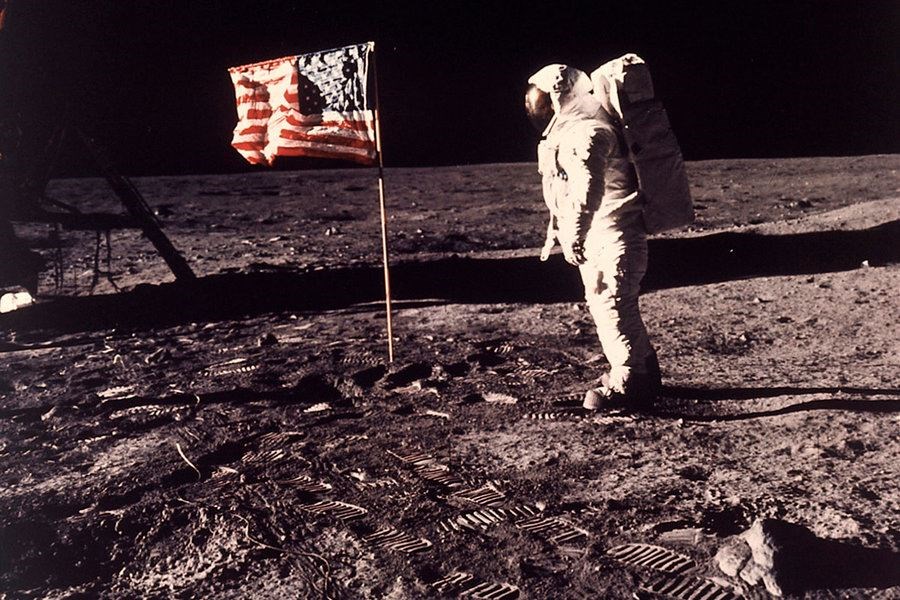 Astronaut Edwin “Buzz” Aldrin stands beside the U.S. flag deployed on the moon during the historic Apollo 11 mission on July 20, 1969.Neil A. Armstrong/NASA/AP/FileFirst came an alarm indicating something awry with the spacecraft. Then another. After a few tense seconds, engineers at Mission Control in Houston decided it wasn’t catastrophic: It was the landing computer on the spacecraft signaling an overload. Charles Duke Jr., the official communicator with the space capsule, or CAPCOM, relayed a message to the astronauts: Proceed.
Astronaut Edwin “Buzz” Aldrin stands beside the U.S. flag deployed on the moon during the historic Apollo 11 mission on July 20, 1969.Neil A. Armstrong/NASA/AP/FileFirst came an alarm indicating something awry with the spacecraft. Then another. After a few tense seconds, engineers at Mission Control in Houston decided it wasn’t catastrophic: It was the landing computer on the spacecraft signaling an overload. Charles Duke Jr., the official communicator with the space capsule, or CAPCOM, relayed a message to the astronauts: Proceed.
Then came the fuel problem. As the lunar module drew closer to its landing site, the Sea of Tranquillity, Mr. Armstrong could see that he would have to make an adjustment. Where existing maps had shown a smooth region, car-sized boulders cluttered a field of craters. Mr. Armstrong had to search for a safe landing spot manually. The catch: It would take precious fuel.
Tensions were high in Houston. Nobody spoke. “You could’ve heard a pin drop” in the room of about 100 people, recalls flight director Gerry Griffin in an interview. Mission controllers listened intently as Mr. Aldrin called out the speed and range of the spacecraft.
“60 seconds,” came the warning from Houston, indicating how much time the astronauts had until a mandatory abort for low fuel. The spacecraft was still about 100 feet above the surface. “30 seconds,” came a second warning.
“Those seconds seemed to be going [by] awfully fast,” says Mr. Griffin.
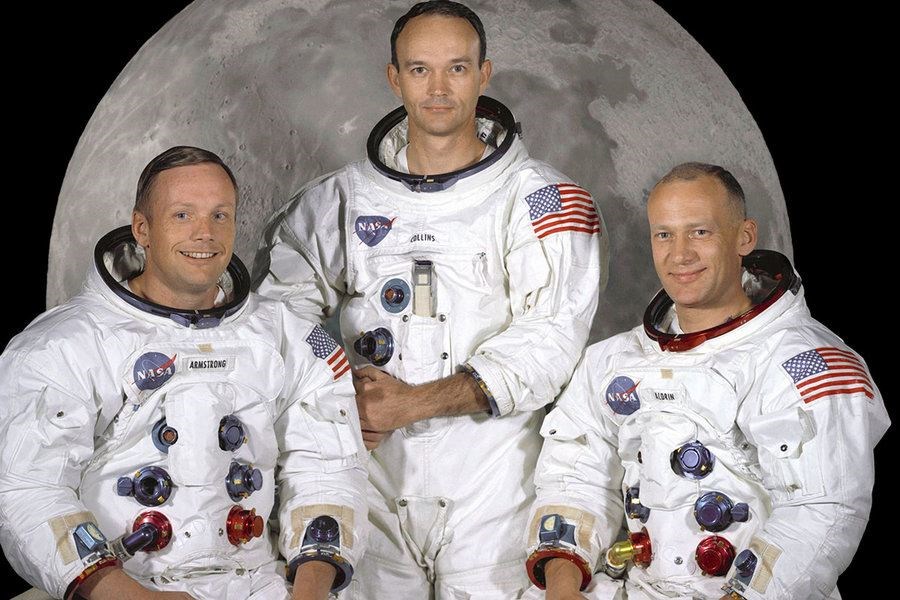 Astronauts Neil Armstrong (left), the first man to walk on the moon; Edwin “Buzz” Aldrin (right), who also walked on the moon; and Michael Collins (center), the command module pilot, made up the Apollo 11 crew.NASA/ReutersFinally, Mr. Aldrin’s voice crackled across the radio: “Contact light.” One of the module’s footpads had touched the surface. A few people in Mission Control pumped their fists. Chief flight director Gene Kranz cautioned everyone to calm down. There was still work to do, and they didn’t have official confirmation from the astronauts. Then, it came:
Astronauts Neil Armstrong (left), the first man to walk on the moon; Edwin “Buzz” Aldrin (right), who also walked on the moon; and Michael Collins (center), the command module pilot, made up the Apollo 11 crew.NASA/ReutersFinally, Mr. Aldrin’s voice crackled across the radio: “Contact light.” One of the module’s footpads had touched the surface. A few people in Mission Control pumped their fists. Chief flight director Gene Kranz cautioned everyone to calm down. There was still work to do, and they didn’t have official confirmation from the astronauts. Then, it came:
“Houston, the Eagle has landed.”
“Roger, Twang ... Tranquillity,” Mr. Duke stuttered back in a Southern drawl. “We copy you on the ground. You’ve got a bunch of guys about to turn blue. We’re breathing again.”
That night in Houston, Mr. Griffin took a moment to look up at the illuminated half-moon in an ink-black sky. “We did it,” he recalls saying to a colleague. “There’s guys sitting up there on that thing that we put there.”
Fifty years ago, the United States did the “impossible.” It landed a man on the moon. It took hundreds of thousands of people and billions of dollars, but NASA achieved one of the great milestones in human history.
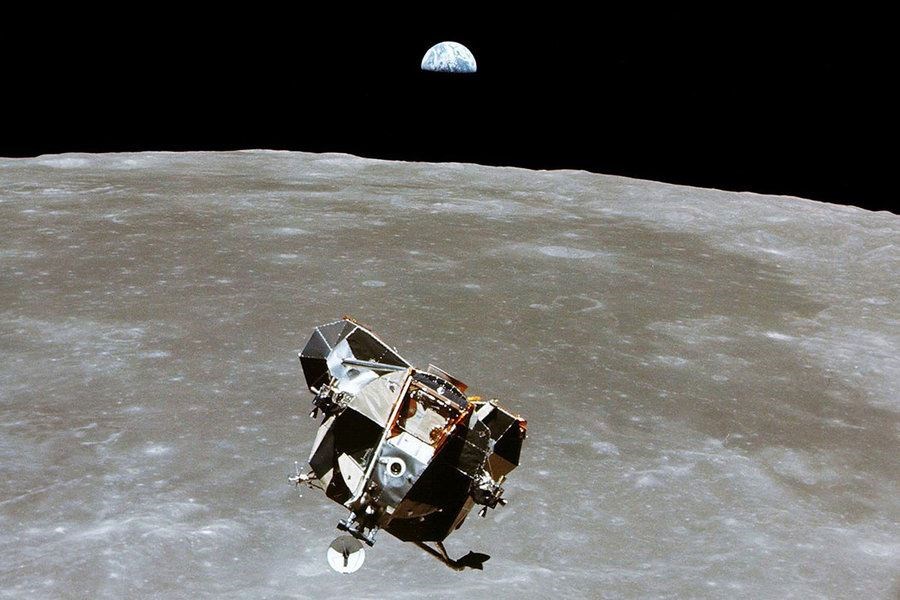 The Apollo 11 lunar lander heads toward a rendezvous with the command module after leaving the lunar surface in July 1969. Earth appears in the background.NASA/ReutersThe dramatic moment temporarily united a nation cleaved by the Vietnam War, boosted the U.S. in its geopolitical clash with the Soviet Union, and opened up the imaginative possibilities of human spaceflight for an entire world.
The Apollo 11 lunar lander heads toward a rendezvous with the command module after leaving the lunar surface in July 1969. Earth appears in the background.NASA/ReutersThe dramatic moment temporarily united a nation cleaved by the Vietnam War, boosted the U.S. in its geopolitical clash with the Soviet Union, and opened up the imaginative possibilities of human spaceflight for an entire world.
Indeed, some 600 million people around the globe watched the grainy footage of Mr. Armstrong’s “giant leap for mankind.” It even gave the world a new cultural metaphor. Prior to the feat, the phrase “it’s like landing on the moon” referred to something that couldn’t be done. Afterward, it meant that, with enough effort, humanity could achieve anything.
Today, as celebrations across the U.S. mark the anniversary of the momentous Apollo 11 mission, people worldwide are once again pondering their next journeys into the cosmos. Several space agencies are planning trips to the moon. Others are looking out farther, to Mars. What will be the world’s next moonshots?
Since the dawn of humanity, the moon has occupied a central place in our consciousness. Unlike other planetary bodies, the moon appears as more than just a pinprick of light in the sky, inviting us to imagine it as another world. It has been the source of infinite mythologies.
In one Buddhist tale, a hare that sacrifices itself to feed a hungry priest is honored by its likeness being etched in the moon’s surface for all to see. Khonsu, the ancient Egyptian moon god, was thought to watch over those who travel at night. In ancient China, the moon represented rejuvenation.
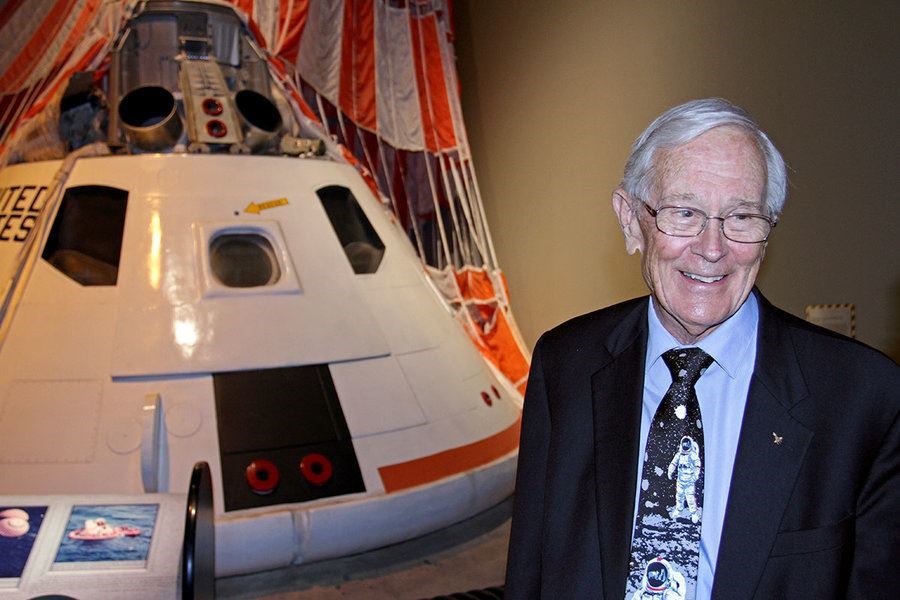 “If your heart can drop to the bottom of your boots in zero gravity, it did,” says Charles Duke Jr., referring to the possibility of not landing on the moon in 1972 because of technical difficulties when the crew was only 8 miles above the surface.Eva Botkin-Kowacki/TCSMThe moon was long seen as a perfect orb, its dark markings explained through legends and other stories. But Galileo’s closer examination of the moon revealed its imperfections, and humanity’s view took on a new dimension: an object worthy of scientific study.
“If your heart can drop to the bottom of your boots in zero gravity, it did,” says Charles Duke Jr., referring to the possibility of not landing on the moon in 1972 because of technical difficulties when the crew was only 8 miles above the surface.Eva Botkin-Kowacki/TCSMThe moon was long seen as a perfect orb, its dark markings explained through legends and other stories. But Galileo’s closer examination of the moon revealed its imperfections, and humanity’s view took on a new dimension: an object worthy of scientific study.
“You’ve got this [second] narrative running – speculation about what conditions are like, what the temperature is like, whether anything lives there,” says Alice Gorman, an expert in space archaeology at Flinders University in Adelaide, Australia. As ground-based study of the moon advanced, it opened up more questions and mysteries.
Despite humanity’s long-held fascination with the moon, and the scientific potential of sending a person there, NASA targeted the planetary body for another reason: power. The U.S. and the Soviet Union were engaged in a global struggle for dominance. Everything was a competition, and space emerged as one of the most visible and prestigious battlegrounds in this existential fight.
“This was war by another means,” says Roger Launius, former chief historian for NASA and author of “Apollo’s Legacy.”
The U.S. was already lagging in the space race since the Soviet launch of Sputnik in 1957. But the nation that landed on the moon would gain an important edge in its quest to lead the world into the future. That’s what lay behind President John F. Kennedy’s speech summoning a nation to the task. “We choose to go to the moon,” he famously said in an address at Rice University in Houston in 1962. “We choose to go to the moon in this decade and do the other things, not because they are easy, but because they are hard.”
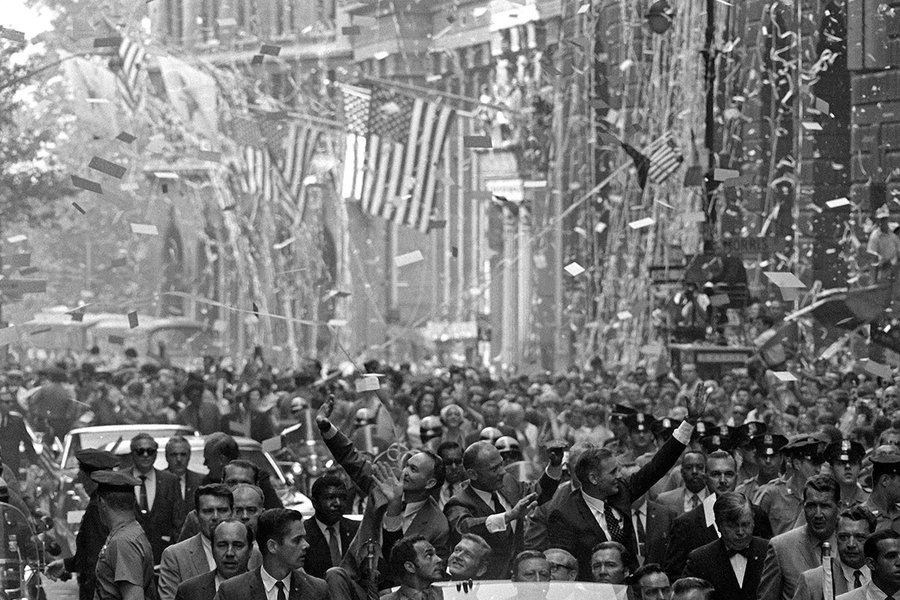 Amid ticker tape and American flags, Apollo 11 astronauts wave during a parade on Broadway in New York on Aug. 13, 1969. The crew (from left) are Michael Collins, Edwin “Buzz” Aldrin Jr., and Neil Armstrong.Eddie Adams/AP/FileAnd hard it was. Washington pumped more than 4% of the federal budget into NASA in the early years of the Apollo program. Today, by comparison, the space agency accounts for about 0.5% of the federal budget.
Amid ticker tape and American flags, Apollo 11 astronauts wave during a parade on Broadway in New York on Aug. 13, 1969. The crew (from left) are Michael Collins, Edwin “Buzz” Aldrin Jr., and Neil Armstrong.Eddie Adams/AP/FileAnd hard it was. Washington pumped more than 4% of the federal budget into NASA in the early years of the Apollo program. Today, by comparison, the space agency accounts for about 0.5% of the federal budget.
The project cost $25 billion and employed 400,000 people – many of whom rarely saw their families because they worked so many hours. Three astronauts died when a fire broke out in their spacecraft during a pre-launch test for what was supposed to be the first crewed mission of the Apollo program. Still, before the decade was over, Mr. Armstrong and Mr. Aldrin had planted an American flag on the moon.
“It was a persuasive event that established in people’s minds around the world ... that the Soviets were not the wave of the future,” says James Oberg, space analyst and former NASA space shuttle engineer. “It was a grand-slam home run.”
The U.S. didn’t lay claim to the moon – the flag was just symbolic – and much of the language around the lunar landing celebrated it as a collective human achievement. Publicly, the Soviets lauded the “giant leap for mankind,” too. But privately, says Mr. Oberg, an expert on the Russian space program, they were devastated.
Although geopolitical posturing drove NASA’s Apollo program, its legacy extends beyond pride and political gain. The six missions that landed on the moon brought back 842 pounds of rocks, core samples, and dust, and set up science experiments that are still paying dividends. The potent symbolism and imagery that emerged from the Apollo missions also profoundly affected global perspectives of both the Earth and ourselves.
From tens of thousands of miles away, the Earth looks like the globe on a teacher’s desk. But the political boundaries are wiped away, and the blackness around it provides a stark contrast to the bright, lively planet hanging in the void of space. The Earth appears as a whole system, interconnected and complete. Although we know intellectually that we live on a planet, astronauts have said viewing it from space gives them a unique understanding of how our world is a small, precious oasis in an expansive cosmos.
“Going to the moon gave us a whole new perspective on what our planet is and what our life means,” says space historian Amy Shira Teitel. Apollo astronauts snapped photos of the Earth from afar that are credited with helping propel the environmental movement in the 1970s.
Scientifically, the Apollo moon landings also taught us a lot about the makeup of the planet. If you want to understand what happened early in Earth’s history, and what may have triggered the rise of life here, “you have to go to the moon,” says David Kring, senior scientist at the Lunar and Planetary Institute in Houston.
The Earth and moon are intimately connected, dancing through space in tandem. So any rocks or radiation that pass through the neighborhood usually affect both. On the Earth’s surface, craters caused by space debris and other indications of what was going on early in our planet’s history have largely been erased by plate tectonics, volcanism, and erosion. On the moon, there’s been little deletion of the geologic record.
As a result, the scientific data and hundreds of pounds of moon rocks gathered during the Apollo missions lifted the veil of mystery not just on the moon but also on the Earth. Before the Apollo program, the origin of the moon was an enigma. Some scientists thought it was a simple asteroid drawn into orbit by Earth’s gravitational pull. Others surmised it was a world of its own.
But Apollo discoveries brought geologists to a scientific consensus: that the body probably formed when a Mars-sized planet smashed into the Earth, sending rocks and dust from both worlds into orbit. There, the debris coalesced into the moon.
“What the Apollo program did was convert the moon from an object of fascination to a place – a place we could explore,” says NASA planetary scientist Samuel Lawrence.
Many of the 12 astronauts who landed on the moon hopped along the surface, using the low-gravity environment to help them move around in their cumbersome spacesuits. Not Harrison “Jack” Schmitt. He preferred to pretend he was cross-country skiing. He skimmed along the dusty landscape – which may have helped him make a serendipitous discovery.
Dr. Schmitt was the first scientist-astronaut, and the 12th and last man to step onto the moon in December 1972. On one lunar walk, the geologist perused the rim of a crater called Shorty, looking for clues to validate a little-supported theory that it was formed by a volcanic eruption rather than from the impact of a space rock. While Dr. Schmitt was shuffling along his boots scuffed below the gray lunar surface to reveal a strangely colored material.
“Oh, hey!” the astronaut exclaimed. “There’s orange soil!”
To anyone else, the orange sediments might have seemed just a curiosity. But Dr. Schmitt knew instantly he had found something important.
“My immediate thought was maybe this thing is volcanic,” he recalls during a recent interview. But he couldn’t be sure until he looked at the grains through a microscope. So he quickly dug a trench to collect a pristine sample of the colorful particles.
Back on Earth, the orange soil did turn out to be volcanic: tiny beads of glass formed from volcanic ash. But the grains formed well before Shorty, meaning it was an impact crater. Still, over the past five decades, geologists have continued to study the orange particles along with green glass collected by the Apollo 15 crew. Both could prove vital to future space travel.
Using basic chemistry, explains Dr. Lawrence, it’s possible to extract resources like water, oxygen, and other chemical ingredients to make propellants. Ice spotted in craters at the moon’s poles could also be used. Together, these revelations have sparked interest in using the moon as a base where spacecraft can refuel en route to more distant places in space.
While the moon has yielded invaluable scientific secrets, it has also provided some colorful vignettes from the people who have walked on its surface. It’s one of the world’s most exclusive fraternities: Only four out of the dozen men who have walked on the moon are still alive.
One of them is Mr. Duke, the ground communicator with Apollo 11. After years of dreaming, years of training, and many tense hours talking Mr. Armstrong and Mr. Aldrin through that inaugural landing, the first thing Mr. Duke did when he got to the moon himself was ... take a nap.
It was April 20, 1972. The lunar module Orion had just settled on the dusty surface. Apollo 16 mission commander John Young and Mr. Duke, the lunar module pilot, would soon descend the wobbly ladder to become the ninth and 10th humans to walk on the moon. But first, they removed their spacesuits, ate supper, and clambered into their sleeping hammocks. Mr. Young dozed off immediately. Mr. Duke found it difficult to quiet his mind. “I was just exploding with joy,” he says.
Sleeping wasn’t by choice. Hours earlier, while the crew waited in lunar orbit, Mission Control had deliberated whether to even attempt the landing. There was a technical problem that Houston thought might jeopardize the ability of the crew to return to Earth.
“If your heart can drop to the bottom of your boots in zero gravity, it did,” Mr. Duke says. “We had trained two years. We’d come 250,000 miles, basically, and our landing spot was 8 miles beneath us. And they were about to tell us to come home.”
Fortunately, six hours later, Mission Control figured out a solution and gave Apollo 16 a go for the fifth landing on the moon. But the delay had shifted the astronauts’ schedule. Houston told them they needed to sleep.
Walking on the moon may be a once-in-a-lifetime experience, but the Apollo astronauts couldn’t just stop and take in the scenery. “You don’t want to waste any time,” Dr. Schmitt says. Time on the moon is precious – and losing any could prove fatal.
Moonwalks and excursions in the lunar rover vehicle were carefully timed so the astronauts wouldn’t run out of air to breathe in their spacesuits. Buffer time was included in case something went wrong. But Dr. Schmitt and mission commander Eugene Cernan had numerous samples to collect and untouched lunar terrain to explore. They had some 22 hours over three moonwalks to do it. Other Apollo missions had even less time.
But that doesn’t mean Dr. Schmitt didn’t notice the environment around him while he worked. He vividly recalls the details of the Apollo 17 landing site. “Imagine being in a valley” deeper than the Grand Canyon, he says, “with a brilliant sun, a blacker than black sky, and the Earth hanging over the southwest wall of the [valley], always in the same place. It doesn’t move. That’s because the moon always keeps the same face towards the Earth.”
With no air on the moon, it’s often described as silent. But Dr. Schmitt says with a chuckle, “It better not be, or you’re going to be in trouble.”
Pumps and fans whirred in the astronauts’ spacesuits to maintain safe body temperatures and circulate oxygen. Temperatures on the moon can range from 260 degrees Fahrenheit to -280 degrees. Apollo astronauts also constantly spoke to each other and checked in with Mission Control over the radio.
Bounding around in cumbersome spacesuits and the unfamiliar low gravity of the moon is tricky. Apollo astronauts took a lot of tumbles. “It’s like being a kid this high again,” Dr. Schmitt says, holding his hand two feet above the floor. “But it’s very easy to get up, because one-sixth gravity doesn’t hold you down.”
Despite being in a place so inhospitable to humans, Dr. Schmitt says he was relaxed. He could often, in fact, be heard singing throughout his mission.
At one point, Dr. Schmitt altered the lyrics to “The Fountain in the Park” by Ed Haley to fit the scene. Instead of crooning “I was strolling through the park one day,” he improvised with “I was strolling on the moon one day.” Mr. Cernan joined in. The duo bounced along the moon, singing as they went about their work.
Whether anyone will ever sing or stroll on the moon again is an open question, especially given that it’s been 47 years since the last landing. Three more Apollo missions were originally planned, but the program ended with No. 17 in December 1972. Humans have not gone back to the moon – or even left Earth orbit – since.
That’s not to say interplanetary aspirations have evaporated. Space agencies and private companies have outlined several grandiose proposals over the past several decades to return to the moon or even go to Mars. None has taken off so far.
NASA’s latest plan is a program called Artemis, named for the Greek goddess of hunting and Apollo’s twin sister. Announced earlier this year, it envisions landing humans on the moon by 2024, with the ultimate goal of establishing a base to test space technologies and act as a way station to Mars.
Funding remains a formidable obstacle. “Where’s the money going to come from and how much money is it going to take?” says space historian Mr. Launius. “That’s really the question you have to ask over and over.”
NASA administrator Jim Bridenstine has estimated that Artemis could cost $20 billion to $30 billion over the next five years on top of the normal NASA budget. The Apollo program represented a singular moment, Mr. Launius says. NASA received the federal funding it needed because of the geopolitical context of the era, which doesn’t exist today.
Still, the Apollo moon missions and the hype surrounding the space race helped spawn a generation of dreamers who want to make deep space travel a reality – with or without government help. Take Jeff Bezos, founder of Amazon and the private spaceflight company Blue Origin.
“We all got to witness [the moon landing] as a civilization and it really made people realize the kinds of things we could do,” he told an audience at the John F. Kennedy Presidential Library and Museum in Boston in June. Mr. Bezos was 5 years old when Mr. Armstrong stepped on the moon, and now he’s leading a company with ambitions to return there. “I definitely got that bug,” he said. “And I kept after it.”
Private aerospace companies such as Blue Origin, SpaceX, and Boeing are vying to build the next generation of rockets and spacecrafts. Boeing and SpaceX are running final tests on systems that could send Americans to the International Space Station by the end of this year.
Entrepreneurs and NASA aren’t the only ones with lofty goals. Russian President Vladimir Putin said in 2018 that his country will begin manned missions to the moon and Mars in upcoming years. China is also establishing a human presence in space.
The quest to some day walk on another planetary body is understandable to those who have already done it. Dr. Schmitt still remembers his last stroll on the lunar surface. As a true geologist, he was picking up rocks one final time. He took a look around the valley, letting his eyes linger on the horizon to commit the alien scene to memory.
What sticks in his mind still today is the stark contrast between the barren lunar landscape under a pitch-black sky and the colorful little module the astronauts had called home for three days.
“It’s more than anybody can describe,” he says of the lunar surface. “It’s a spectacular place to be.”
Page created on 7/16/2019 3:49:07 PM
Last edited 7/16/2019 4:06:47 PM
